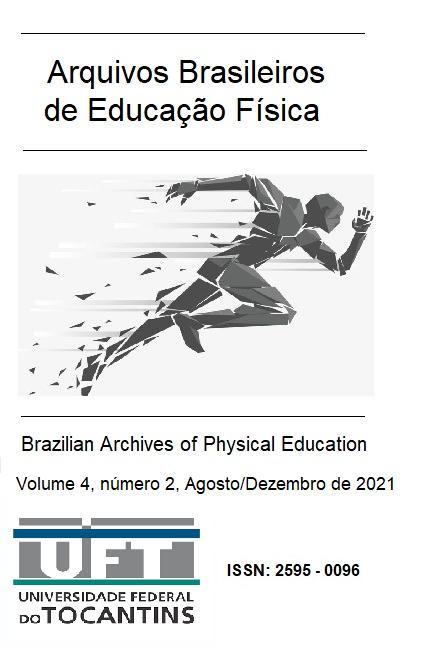OVERWEIGHT IN ADOLESCENTS IN A MUNICIPALITY OF MINAS GERAIS IN 2019 AND 2020
DOI:
https://doi.org/10.20873/abef.2595-0096v4n2p150158Keywords:
Nutritional Status. Adolescent. Primary Health Care. COVID-19 pandemic.Abstract
Adolescence, from 10 to 19 years of age, is a phase characterized by biopsychosocial changes such as changes in weight, height, body composition, physiological changes in internal organs and bone growth. Assessment of nutritional status aims to verify growth and body proportions establishing intervention attitudes. Adolescents have been considered at nutritional risk due to their eating habits, as they sometimes fail to make healthy foods, replacing them with snacks with low nutritional value, this fact seems to have worsened in the COVID-19 pandemic. Objective: to present the nutritional status of adolescents monitored in Primary Health Care through the Food and Nutritional Surveillance System - SISVAN in 2019 and 2020, years before and after the beginning of the COVID-2019 pandemic. Methodology: This is a descriptive study. For the classification of the nutritional status of adolescents, the World Health Organization was adopted as a reference and the Body Mass Index was used. Results: In 2019, 1892 adolescents were registered in the SISVAN, which represents 5.5% of adolescents in the municipality. In that year 26.90% were overweight. In 2020, the year in which the COVID-19 Pandemic began, 2,163 adolescents were monitored, representing 5.5% of adolescents in the municipality. This year, 33.94% of the adolescents monitored were overweight according to the BMI for their age, which represents an increase of 26.17%. Conclusion: It is important to record the nutritional status of adolescents in SISVAN for a better diagnosis of the prevalence of weight, especially obesity, in order to know the real picture of this problem in the city, especially during and after the COVID-19 pandemic. Overweight is a serious and prevalent problem in adolescents, requiring new practices of effective operations related to healthy eating and physical exercise in order to change this scenario.
References
WHO. World Health Organization. 2018. Obesity and overweight fact sheet. Disponível em: <https://www.who.int/en/news-room/fact-sheets/detail/obesity-and-overweight>.
BRASIL. Ministério da Saúde. Secretaria de Atenção à Saúde. Departamento de Ações Programáticas e Estratégicas. Proteger e cuidar da saúde de adolescentes na atenção básica. 2. ed. – Brasília: Ministério da Saúde, 2018. Disponível em: https://bvsms.saude.gov.br/bvs/publicacoes/proteger_cuidar_adolescentes_atencao_basica_2ed.pdf
AZZOLINO D, PASSARELLI PC, D'ADDONA A, CESARI M. Nutritional strategies for the rehabilitation of COVID-19 patients. Eur J Clin Nutr. 2020;1-3.
BRUGLIERA L, SPINA A, CASTELLAZZI P, et al. Nutritional management of COVID-19 patients in a rehabilitation unit. Eur J Clin Nutr. 2020;74(6):860-863.
DE BIASE S, COOK L, SKELTON DA, WITHAM M, TEN HOVE R. The COVID-19 rehabilitation pandemic. Age Ageing. 2020 Aug 24;49(5):696-700.
BRASIL. Ministério da Saúde. Secretaria de Atenção à Saúde. Departamento de Atenção Básica. Orientações para a coleta e análise de dados antropométricos em serviços de saúde: Norma Técnica do Sistema de Vigilância Alimentar e Nutricional. Brasília: Ministério da Saúde, 2011. Disponível em: http://189.28.128.100/dab/docs/portaldab/publicacoes/orientacoes_coleta_analise_dados_antropometricos.pdf%20portaldab/documentos/errata_normatecnica_sisvan.pdf
BRASIL. Ministério da Saúde. Secretaria de Atenção à Saúde. Departamento de Atenção Básica. Protocolos do Sistema de Vigilância Alimentar e Nutricional – SISVAN na assistência à saúde. Brasília: Ministério da Saúde, 2008. Disponível em: http://189.28.128.100/dab/docs/portaldab/publicacoes/protocolo_sisvan.pdf
BRASIL. Ministério da Saúde. Secretaria de Atenção à Saúde. Departamento de Atenção Básica. Marco de referência da vigilância alimentar e nutricional na atenção básica. Brasília: Ministério da Saúde, 2015. Disponível em: https://bvsms.saude.gov.br/bvs/publicacoes/marco_referencia_vigilancia_alimentar.pdf
BRASIL. Ministério da Saúde. Secretaria de Vigilância em Saúde. Departamento de Análise em Saúde e Vigilância de Doenças Não Transmissíveis. Vigitel Brasil 2019: vigilância de fatores de risco e proteção para doenças crônicas por inquérito telefônico. Brasília: Ministério da Saúde, 2020. Disponível em: https://bvsms.saude.gov.br/bvs/publicacoes/vigitel_brasil_2019_vigilancia_fatores_risco.pdf
BRASIL. Ministério da Saúde. Secretaria de Atenção à Saúde. Departamento de Atenção Básica. Manual Operacional para Uso do Sistema de Vigilância Alimentar e Nutricional Sisvan – Versão 3.0 Brasília – DF: 2017. Disponível em: http://sisaps.saude.gov.br/sisvan/public/file/ManualDoSisvan.pdf
PMS. Plano Municipal de Saúde 2018/2021 – Deliberado pelo Conselho Municipal de Saúde em 31 de janeiro de 2018 (Resolução CMS nº 21/2018). Divinópolis, 2018.
BATISTA, MCF. Análise da Implementação do Projeto Fortalecimento da Agricultura Familiar para o Abastecimento Alimentar e Suas Contribuições para o Programa Nacional e Alimentação Escolar – PNAE. Belo Horizonte, 2015.
SANTOS LAS. Educação alimentar e nutricional no contexto da promoção de práticas alimentares saudáveis. Revista de Nutrição. 2005; 18(5): 681-692.
COSTA, MHBC; GUIMARÃES, SM; BORGES JA. Experiência de Política Integrada de Segurança Alimentar e Nutricional Sustentavel (SANS) em Minas Gerais. Segurança Alimentar e Nutricional, Campinas, 24(1):62-74, 2017.
CONASS. Nota Técnica: Nº 07/2013 - Estratégia E-Sus Atenção Básica e Sistema de Informação em Saúde da Atenção Básica – SISAB. Brasília: 2013. Disponível em: https://www.conass.org.br/biblioteca/wp-content/uploads/2013/01/NT-07-2013-e-SUS-e-SISAB.pdf
Downloads
Published
How to Cite
Issue
Section
License
Proposal for Copyright Notice Creative Commons
1. Policy Proposal to Open Access Journals
Authors who publish with this journal agree to the following terms:
A. Authors retain copyright and grant the journal right of first publication with the work simultaneously licensed under the Creative Commons Attribution License that allows sharing the work with recognition of its initial publication in this journal.
B. Authors are able to take on additional contracts separately, non-exclusive distribution of the version of the paper published in this journal (ex .: publish in an institutional repository or as a book), with an acknowledgment of its initial publication in this journal.
C. Authors are permitted and encouraged to post their work online (eg .: in institutional repositories or on their website) at any point before or during the editorial process, as it can lead to productive exchanges, as well as increase the impact and the citation of published work (See the Effect of Open Access).

